<< Previous | Displaying results 4251-4300 of 6769 for "" | Next >>
In July 1938, delegates from 32 countries met in Evian, France for a conference on the refugee crisis. The delegates expressed sympathy for the Jews who were seeking to flee Nazi persecution. Most countries, however, refused to admit more refugees.
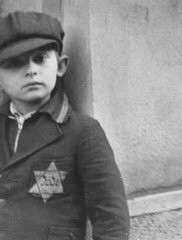

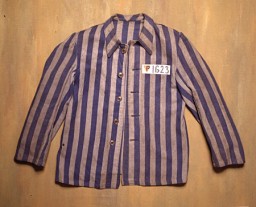

On December 7, 1941, Japan launched an attack on the American navel base at Pearl Harbor. The following day, the United States declared war on Japan, entering into World War II. World War II in the Pacific ended when Japan surrendered on Sep...
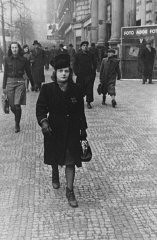
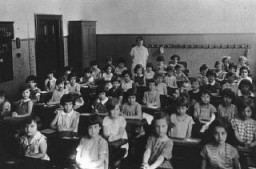
The Nazi regime carried out a campaign to "cleanse" German society of individuals they viewed as biological threats. Even before the Nazi rise to power, many German doctors and scientists supported ideas about racial hygiene. During World War II, a number of German physicians conducted painful and often deadly experiments on thousands of prisoners without their consent.
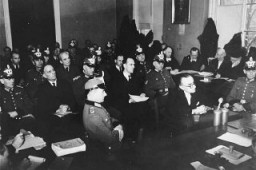
The French government established the Gurs camp in April 1939, before war with Germany and wel...
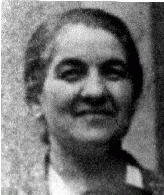
The French government established the Gurs camp in 1939, before the war began and before Germany occupied France. Gurs initially served as a detention center for political refugees and later held German Jewish refugees. In June 1940, France signed a...
J Malan Heslop was a photographer in the US Army Signal Corps. After the camps were liberated, the Signal Corps had a key role in documenting the atrocities of the Holocaust. Heslop captured the plight of survivors in the Ebensee subcamp of Mauthaus...
A childsize violin that belonged to Boruch Golden (Gordon), who was killed along with his mother and brother at the Ponary killing site in September 1943. Boruch was born in 1930, and was one of four children. His parents, Moshe and Basia Golden (Gordon), raised their family in Swieciany (Svencionys), Lithuania. After the German invasion of the Soviet Union in June 1941, the family was forced into the Swieciany ghetto. When that ghetto was later liquidated in 1943, the family was sent to the Vilna…
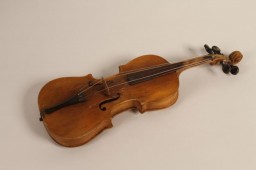
Nazi propaganda poster titled “The Stalin Constitution?” printed October 10, 1943. The Nazis often used propaganda in occupied territories to secure the compliance and even support of local populations. In Ukraine and other occupied regions of the Soviet Union, the Nazis created propaganda that exploited preexisting discontent with the Soviet regime. They also tried to exploit preexisting anti-Jewish sentiment and sharpen divisions between Jews and non-Jews. One way of achieving this was by creating…
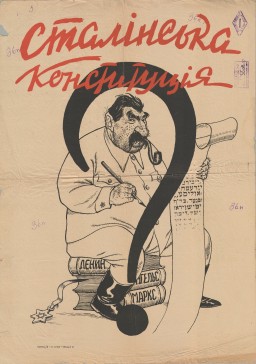
This large, lidded wooden chest was used by the Council for Aid to Jews (codenamed “Żegota”) to hide false identity documents from Nazi authorities. Żegota was an underground rescue organization of Poles and Jews in German-occupied Poland and operated from December 1942 to January 1945. Supported by the Polish government-in-exile, it coordinated efforts to save Jews in German-occupied Poland from Nazi persecution and murder. One of Żegota’s most impactful clandestine activities was producing and…
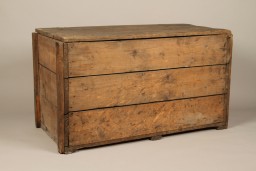
Poster titled “The United Nations Fight For Freedom.” It was one of many posters produced by the Office of War Information, the United States’s official propaganda agency during World War II. Canadian-American commercial artist Steve Broder (1902-1992) designed this work to bolster confidence in the Allied war effort against the Axis Powers (Nazi Germany, Fascist Italy, and Imperial Japan). It depicts the 30 flags of countries that signed the Declaration by the United Nations and declared war on the…
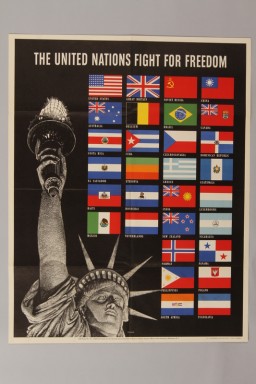
Drawing of the SS Patria, part of the illustrated diary of Egon Weiss which he compiled during and immediately after his detention in the Atlit internment camp.
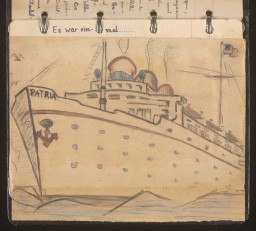
Carl Atkin was United Nations Relief and Rehabilitation Administration (UNRRA) director at the Deggendorf displaced persons camp. He received a songbook created by the survivors in his care. This page shows one of the songs compiled in the book.
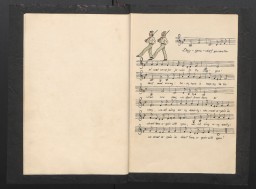
In the 25-point program, Nazi Party members publicly declared their intention to segregate Jews from "Aryan" society and to abrogate Jews' political, legal, and civil rights. Germany, 1931.
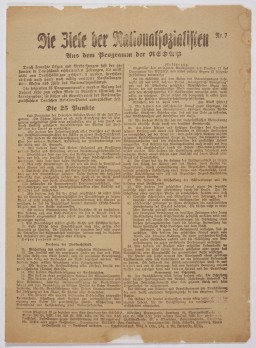
On September 5, 1942, the SS and Police Leader of the Warsaw District issued this announcement threatening the death penalty for anyone who aided Jews who had left the ghetto without authorization. This poster was put up in the wake of the mass deportation of Jews from the Warsaw ghetto to the Treblinka killing center in summer 1942. SS officials were well aware that thousands of Jews had fled the ghetto to go into hiding and urged people to turn them in. The poster reminds the city's non-Jewish…
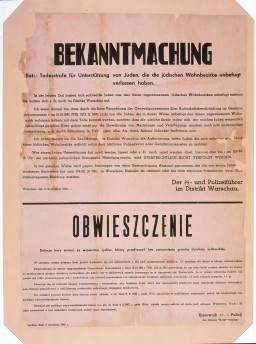
During the interwar period Dr. Susanne Engelmann served as the principal of a large public high school for girls in Berlin. This letter notified her of her dismissal, as a "non-Aryan," from her teaching position. The dismissal was in compliance with the Civil Service Law of April 7, 1933. On April 7, the German government issued the Law for the Restoration of the Professional Civil Service (Gesetz zur Wiederherstellung des Berufsbeamtentums), which excluded Jews and political opponents from all civil…
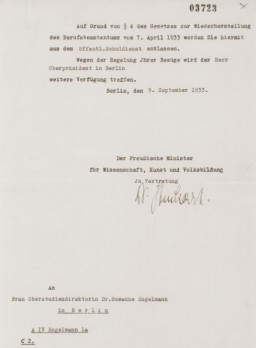
Safe conduct pass issued to Hans Landesberg in the Djelfa internment camp, releasing him to leave for Algiers. Djelfa, Algeria, January 26, 1943. Hans was born in Vienna, Austria, and went to medical school. After graduating, he left for Paris and joined a battalion of the International Brigade to fight in the Spanish Civil War. He returned to France in February 1939, only to be interned first in Argeles and then in Gurs. Some time after the French surrender to Nazi Germany in June 1940, Hans and other…
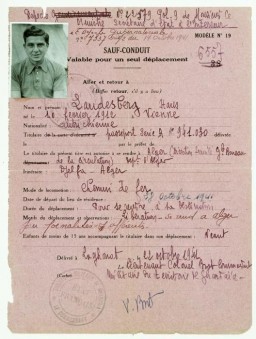
A letter written by the Berlin transit authority (Berliner Verkehrs Aktiengesellschaft) to Viktor Stern, informing him of his dismissal from his post with their agency as of September 20, 1933. This action was taken to comply with provisions of the Law for the Restoration of the Professional Civil Service. On April 7, the German government issued the Law for the Restoration of the Professional Civil Service (Gesetz zur Wiederherstellung des Berufsbeamtentums), which excluded Jews and political opponents…
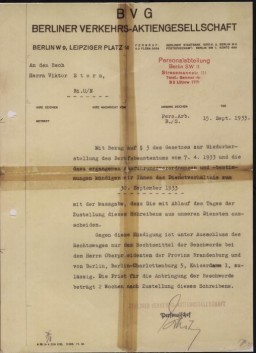
A notice sent by the American Consulate General in Berlin to Arthur Lewy and family, instructing them to report to the consulate on July 26, 1939, with all the required documents, in order to receive their American visas. German Jews attempting to immigrate to the United States in the late 1930s faced overwhelming bureaucratic hurdles. It was difficult to get the necessary papers to leave Germany, and US immigration visas were difficult to obtain. The process could take years.

Seward Daily Gateway (Alaska) article from April 14, 1933, titled "Great Bonfires of Forbidden Books in Germany to Blaze." This article from Berlin, written the month before the book burnings took place, reported that "Great bonfires will be burning on the campus of German universities in a few days, when the latest Nazi decree goes into effect. The Hitler regime is continuing its nationalistic crusade, has ordered that all books which deal with non-German subjects or espouse non-German causes, must be…
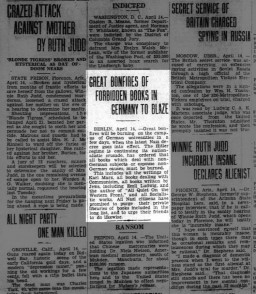
Selmar and Elsa Biener joined the waiting list for US immigration visas in September 1938. Their waiting list numbers—45,685 and 45,686—indicate the number of people who had registered with the US consulate in Berlin. By September 1938, approximately 220,000 people throughout Germany, mostly Jews, were on the waiting list.
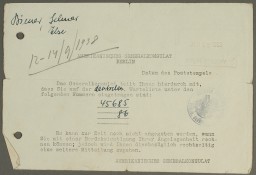
This document is one page of a letter from artist Esther Lurie, written after the war, asking for help in following down leads and locating the artwork she had created and hidden while imprisoned in the Kovno ghetto, Lithuania. She wrote, "The matter concerns a collection of 200 pen-and-ink drawings representing scenes of ghetto life which I made during my internment in the Kaunas Ghetto (Lithuania) in 1941-1944. I left the drawings buried in the earth as I felt that I had no hope of survival."

Ilona Kellner and her family lived in Pelsöc, which became part of Hungary before World War II. Following the German occupation of Hungary, Ilona, her sister Vera, and her parents Karoly and Jolan were forced into a ghetto in another area of the town. In mid-June, the family was deported to the Auschwitz camp in German-occupied Poland. Ilona's parents were killed in the gas chambers at Birkenau. In early August, Ilona and her sister were deported to Hessisch Lichtenau, a subcamp of the Buchenwald…
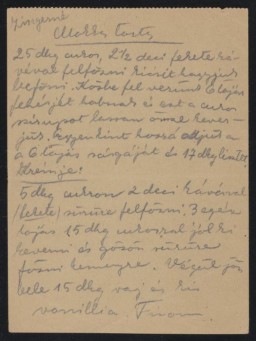
Ilona Kellner and her family lived in Pelsöc, which became part of Hungary before World War II. Following the German occupation of Hungary, Ilona, her sister Vera, and her parents Karoly and Jolan were forced into a ghetto in another area of the town. In mid-June, the family was deported to the Auschwitz camp in German-occupied Poland. Ilona's parents were killed in the gas chambers at Birkenau. In early August, Ilona and her sister were deported to Hessisch Lichtenau, a subcamp of the Buchenwald…
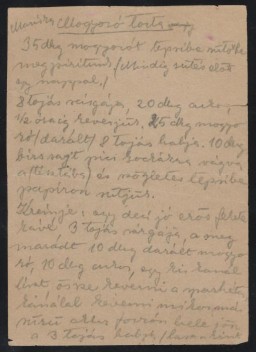
Ilona Kellner and her family lived in Pelsöc, which became part of Hungary before World War II. Following the German occupation of Hungary, Ilona, her sister Vera, and her parents Karoly and Jolan were forced into a ghetto in another area of the town. In mid-June, the family was deported to the Auschwitz camp in German-occupied Poland. Ilona's parents were killed in the gas chambers at Birkenau. In early August, Ilona and her sister were deported to Hessisch Lichtenau, a subcamp of…

Ilona Kellner and her family lived in Pelsöc, which became part of Hungary before World War II. Following the German occupation of Hungary, Ilona, her sister Vera, and her parents Karoly and Jolan were forced into a ghetto in another area of the town. In mid-June, the family was deported to the Auschwitz camp in German-occupied Poland. Ilona's parents were killed in the gas chambers at Birkenau. In early August, Ilona and her sister were deported to Hessisch Lichtenau, a subcamp of the Buchenwald…
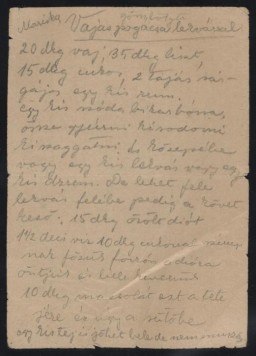
Rudolph Daniel Sichel (b. 1915) left Germany in 1934 for England and then immigrated to the United States in 1936. His father, who had remained in Germany, was arrested during Kristallnacht, sent to Buchenwald for a couple of months, forced to sell his store at a loss, and immigrated to the United States with Rudolph's mother shortly after. Sichel joined the US Army in 1943, attending courses at the Military Intelligence Training Center at Camp Ritchie, MD. He landed on Utah Beach in July 1944 and was…
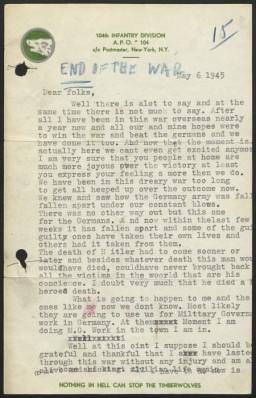
A certificate of "Aryan" descent, issued to Joseph Schäfer of Mühlheim, Germany. To prove one's "Aryan" racial status in Nazi Germany, an individual had to trace their ancestry back to 1800. Signed by an official justice of the peace, this certificate attests to Schäfer's parentage and baptism. Dated January 14, 1936.
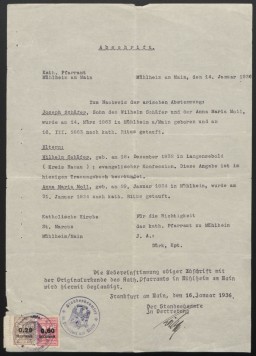
A newspaper advertisement for the Damenklub Violetta, a Berlin club frequented by lesbians, 1928. Before the Nazis came to power in 1933, lesbian communities and networks flourished in Germany.
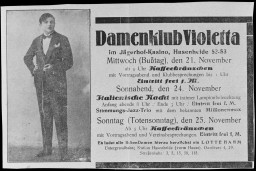
Ada Abrahamer kept a diary from September 1939 until March 1946, though only the pages from 1944-1946 survived. Ada’s diary documents her experiences as a young Jewish woman in German-occupied Poland. German authorities imprisoned Ada in the Krakow ghetto and several forced labor and concentration camps, including Auschwitz. In later entries, she describes her liberation and life after the war. In this entry from August 1944, Ada describes finding love while being imprisoned in Plaszow concentration…
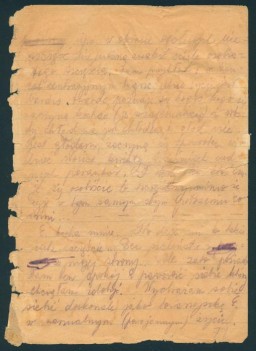
We would like to thank Crown Family Philanthropies, Abe and Ida Cooper Foundation, the Claims Conference, EVZ, and BMF for supporting the ongoing work to create content and resources for the Holocaust Encyclopedia. View the list of donor acknowledgement.